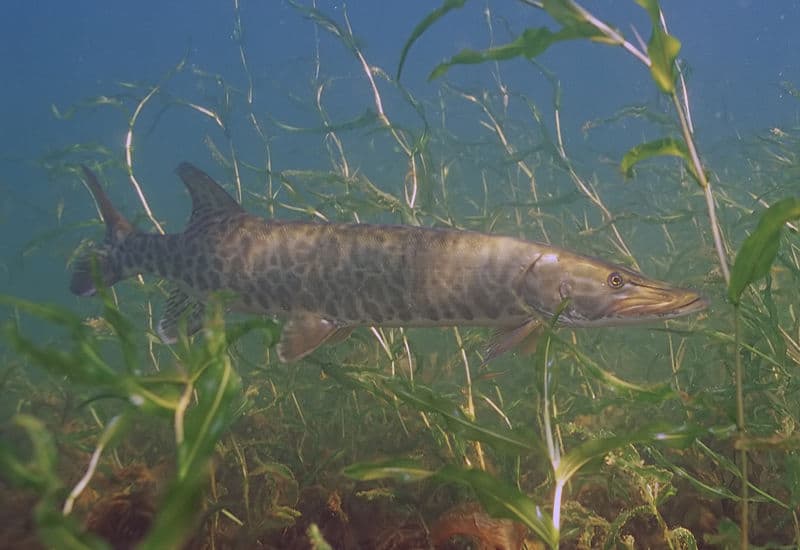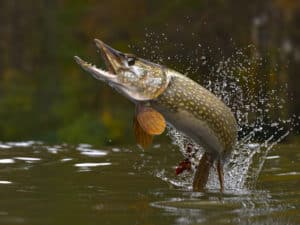Are you planning to fish for northern pikes and wondering whether you have any chance to break Arizona’s record for the largest specimen? If so, you’re in the right place!
Today, we’ll tell you some basic details about northern pikes, how large they typically get, and what’s the largest ever caught in Arizona. Moreover, we’ll share some tips about the best time to catch northern pikes and which Arizona waters they inhabit.
What Is a Northern Pike?

The northern pike is a carnivorous fish living in brackish and freshwater habitats, primarily in the Northern Hemisphere.
©bekirevren/Shutterstock.com
The northern pike is scientifically known as Esox lucius. It’s a carnivorous fish living in brackish and freshwater habitats, primarily in the Northern Hemisphere. In the United States, the fish is known simply as a pike. They inhabit shallow, weedy ecosystems in lakes and reservoirs with cold and clear waters.
Northern pikes are ferocious predators that exhibit ambushing behaviors. They eat small invertebrates when young, moving on to bigger prey as they mature. Sometimes they even try preying on large waterbirds. In 2016, a northern pike tried to drown and feed on a great crested grebe, while the previous year, one tried to kill an adult mute swan. When prey is scarce, these fish may also engage in cannibalistic behaviors. Moreover, they’re a pretty aggressive fish species, especially regarding feeding and “personal space.”
These fish are typically olive green, with shades of yellow and white along their bellies.
How Big Do Northern Pikes Get?
Northern pikes typically reach lengths of 16 – 22 inches. Most fish typically weigh around 2 to 5 pounds, though on rare occasion some individuals reach around 20 pounds. However, some can grow much larger, reaching up to almost 60 inches in length and 60 pounds in weight!
It is generally believed that northern pikes grow larger in Eurasia’s coastal regions. These fish are much smaller in Eurasia’s inland regions and North America.
What’s the Largest Northern Pike Ever Caught in Arizona?

The largest northern pike ever caught in Arizona measured 49 inches long.
The largest northern pike ever caught in Arizona measured 49 inches long! Besides having an extraordinary length, the northern pike weighed 32 pounds and 5.6 ounces! It was caught at Ashurst Lake by angler Ronald Needs. This happened almost two decades ago, on November 5, 2004.
If we were to compare this northern pike with the average length of its species, we’d say this specimen reached a gargantuan size! Moreover, if the average weight is 2 to 5 pounds and the pike caught by Ronald Needs weighed 32 pounds, does that make it a giant northern pike? After all, it weighs almost ten times more than the average fish!
What Is the Second-Largest Northern Pike Ever Caught in Arizona?
Since we’ve also found the second-largest northern pike ever caught in Arizona, we couldn’t avoid sharing it with you! It was not much smaller than the northern pike caught by Ronald Needs, measuring 44 inches! It was caught almost a decade later, on the 26th of April 2013. Scott A. Webster was fishing at Upper Lake Mary when he caught the giant northern pike!
Which Lakes in Arizona Have Northern Pikes?
First, you should know that northern pikes prefer shallow water and habitats filled with aquatic weeds, so if you’re going fishing, look for those! Besides, the Arizona Game and Fish Department advises that northern pike were found in Ashurst Lake, Lake Mary, and Long Lake south of Flagstaff. Some specimens were also spotted in the Show Low/Lakeside area and Rainbow and Fools Hollow.
What’s the Best Time of the Year to Fish for Northern Pikes?
You can fish for northern pikes anytime between mid-May and mid-February; at least, that’s when most inland northern pike seasons “operate.”
However, some anglers recommend fishing during the fall, when the water temperature slowly starts dropping because there’s more oxygen in the water and higher levels of prey fish activity. Consequently, this is also the time when northern pikes are actively hunting. Reportedly, September and October are the best months.
Another reason northern pikes may be more active when fall sets in is that nights get longer. Since they primarily hunt during the day, they may become very hungry during long autumnal, and wintery nights, so they aggressively hunt during the day.
However, if we were to judge upon the Arizona records we’ve mentioned above, we can definitely say that if you’re doing this right, you can catch a northern pike during the spring too!
When Is the Best Time of Day to Fish for Northern Pikes?

Most anglers contest that early hours at first light are usually the best.
©Engbretson, Eric – Public Domain
If you’ve already chosen the month you want to fish for the biggest northern pike that you’ve ever caught, you’re probably wondering which hours are best for fishing. Most anglers suggest that early hours at first light are usually the best. You can wait until midday or even later if you observe lots of activity.
Remember that northern pikes generally hunt when there’s enough sunlight because they heavily rely on their eyesight to search for prey. So if you plan to fish during the fall, ensure you arrive at the site before sunrise to prepare for what may become your best fishing experience!
What’s the Largest Northern Pike Ever Caught?
Some sources state that the maximum recorded northern pike length was 59 inches long. However, we couldn’t find accurate information stating that this particular specimen was caught or observed only.
What we can confirm, though, is that the International Game Fish Association recognizes a 55-pound-heavy northern pike as the largest caught specimen! It even got into Guinness World Records! Lothar Louis caught this northern pike on October 16, 1986 at Greffern Lake in Germany.
Where is Ashurst Lake Located on a Map?
Situated on the Anderson Mesa and approximately 20 miles southeast of Flagstaff, Ashurst Lake is a small body of water that is one of the scarce natural lakes in the state of Arizona, with most of them located in the surrounding area.
Here is Ashurst Lake on a map:
The photo featured at the top of this post is © Ken Hammond - Public Domain
Thank you for reading! Have some feedback for us? Contact the AZ Animals editorial team.






